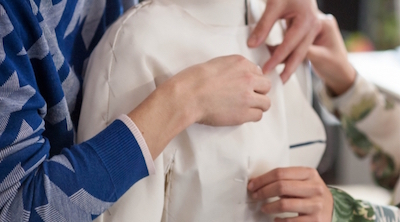French conglomerate Kering Group is crafting tomorrow’s luxury with a three-pillar roadmap to future sustainability.
For more than a decade, Kering, which owns brands such as Gucci and Stella McCartney, has placed sustainability at the core of its business operations, demonstrating that ethical practices are a necessity and possible within luxury. Kering’s new roadmap will lead the company into 2025 using pillars of Care, Collaborate and Create as a guide for the future of its business.
"This strategy is a continuation and an extension of our 2016 Sustainability Targets and strategy," said Marie-Claire Daveu, chief sustainability officer and head of international institutional affairs at Kering. "We have stepped up our ambitions overall and further aligned it with our business priorities.
"Whereas a key focus was on the environmental side, this next phase incorporates a 360-degree approach for internal and external social advocacy, the extension of our scope of key raw materials and processes and higher levels of animal welfare standards, as examples," she said. 'We are also focusing heavily on innovation and encouraging new business models to drive environmental and social sustainability.
"As leaders and trendsetters in fashion, luxury has an inherent responsibility to champion sustainability. With the launch of the next phase of our sustainability strategy today we are setting the highest social and environmental standards in our own luxury sector, with a view to this having influence in the industry overall."
Sustainable vision
Kering’s latest sustainability strategy will encompass 360 degrees of its operations, reaching across its entire supply chain over the next decade.
Through these efforts Kering will lessen its environmental impact, advocate for social welfare internally and at-large as well as create innovative platforms. Doing so will allow the conglomerate to support a low-carbon economy, shape luxury’s future as sustainable and operate within the “planetary boundaries.”
Acknowledging that it must go beyond the conventional limits of its own operations to become truly sustainable, Kering turned to the United Nation’s Sustainable Development Goals (SDGs) to pinpoint quantifiable targets to be achieved by 2025.
From this stemmed the three pillars of Kering sustainability goals: Care, Collaborate and Create.

Care. Image courtesy of Kering Group
Care will see Kering use resources within the planetary boundaries through a science-based approach to reduce carbon emissions by 50 percent by 2025. Also, Kering will address the environmental impacts of its supply chains hoping to reduce its footprint by 40 percent in terms of water use, air and water pollution, waste production and land use.
Within Care, Kering will also create a “Supplier Index of Sustainability” to ensure its raw materials are sourced by trusted and ethical suppliers.This will include traceability, animal welfare, chemical use and social welfare.
For its jewelry and watch business, Kering will establish a Material Innovation Lab (MIL), similar to Kering’s MIL for fabrics and textiles. Doing so will promote sustainable design and make sustainable materials more readily available.

Collaborate. Image courtesy of Kering Group
Kering’s Collaborate pillar rests on its continued support of craftsmanship, traditions and communities. To measure its performance in this regard, Kering plans on developing a metric system based on the UN’s SDGs.
Collaborations will extend all along Kering’s supply chain from communities where raw materials are sourced to in-house employees. Kering will also continue to support its many educational ventures, with focus on identifying sustainable solutions.
For example, Kering and Parsons School of Design collaborated on a new course to measure the environmental impact of designs. The new addition to the curriculum measures the sustainability impact of designs made during the class.
The course leverages the Kering x Parsons: Environmental Profit & Loss program and uses the My EP&L mobile application as a measurement tool for students to better understand the environmental impact of their designs (see story).

Create. Image courtesy of Kering Group
Kering’s last pillar, Create will see the conglomerate invest in disruptive innovations and new business models.
The company plans to develop new and sustainable solutions for sourcing raw materials, for example. These solutions include exploring biotech and promoting a circular economy via recycling used garments and materials.
A Young Leaders Advisory Group will also be established to brainstorm future solutions.
Kering 2025: Crafting tomorrow’s luxury
"More and more industries started to be involved in the active discussion about the sustainable world, and fashion and luxury business is not an exception," said Yana Bushmeleva, COO of Fashionbi.
"The luxury brands were always leading the fashion industry, being the example for other players in terms of the trends/creativity and marketing. Sustainability is another big trend and you need to innovate in order to keep your position on the market," she said.
"Luxury brands can have enough resources to be at the head of this trend. However, today activewear brands are more vocal in spreading their sustainable initiatives and new product launches."
Advocates abound
Kering’s transparency and dedication to the environment and ethical practices are likely a draw for potential employees.
Social advocacy is stressed by Kering, not only through brand-wide initiatives such as the ongoing Kering White Ribbon program (see story), but also by forward-thinking employment practices.
For example, Kering Group furthered its advocacy for women’s rights with the introduction of a parental leave policy for all employees globally.
Employees of Kering’s corporate offices as well as those working for brands within its stable for more than a year are now eligible for parental leave. Kering employs more than 38,500 employees in about 60 countries.
Given its global reach, it is likely that many of its employees’ home countries do not offer such programs for those beginning or growing their families. Kering’s new parental leave policy went into effect on Jan. 1, 2017 (see story).
But, nonetheless, it is important for Kering to transmit its practices to the consumer through campaigning, otherwise its approach will not be known to the general public.
"I believe Kering can have positive results in sales and also in the perception of the company and its brands if the company will properly communicate these next-generation sustainability goals and targets to its current and potential customers in a right way," Ms. Bushmeleva said.
"It's not the first time that Kering set up concrete sustainability goals—in 2012 it already formulated a series of targets to achieve by 2016 and not long ago released the report—but I wonder if this information reached the end consumers of the company, since at the end they 'vote' with their money by purchasing the brands," she said.
"So it's a matter of the communication and PR, for sure a press release is not enough, if we want to reach the mass we need to have some viral campaign during the entire period of the initiative."
{"ct":"zPNu15E4\/Lwl2Zxw0CPlwV8TIX875vQkBnTJVYGiO9h4SjaTH5R5M1QhA6uyNsM674ZlCMzmKPGaP2W+KDtzywINzJIwZ\/JgDc3bJfxD4dUynrXdUjELRWyi0VZPPbumuM1Jzzh75Pu2lKpPL7j9\/SunQHccf3\/mhpH4b\/rNvAeygrusXD+Wm5lJPJvGYTpHk1IkxG5OZR+Inp9hcq9yvTpN2VYdG9XdI1fU0viNpefUa4GYzPB6vxE4jauQ5G17HFMTeFngUqoXJUzxe+th6cLOevCUC5ooACM\/2PmdQqwYyxtqJ87DAIkImOKLJOqsnrNnenlaZud8hndA6PFme\/S2tog4Iq11tMlNJZmWgmMdYLB8UFj4Rn1DSHLnhogHcz6+qRYpl4VZA3wZlIwgeYEYLC18cJIbRsSyyxVCXvQsSAYrhgQfXUkG3Ko0E7QVTG9145bWfx8WpOs4pP\/4CjM+v9hhnPFxNKqP33ZKkhCI4MiTRqeWf8BZqRGefeXn+xalfP+0QgC7BjvMNqQ1TO6KZ\/TJTwPEHjpqv6vAJuhGIlR5f4m\/N7\/+0ZEw523ST4hvT9wgZHAuUcrf6p+IytLwe9HeQwMwZIhW6oW2d6+HkhF9YW6pHcdELLioH\/RCIYNsnvffq0NW1\/uGZGO\/Hpbg8HUHd+PXQLx2wjuc04XlHk5JY2rm+0wMWIWfQr55OdQ0peIDwVhXLpk0pkkmqipPO1X+UWKQU5m8HmqdDKOqHs0PPk9M+nlb4x9l8Na3QQAHEfS1x0uaM0UMQXe13GJxfZMMLYxh3CeTIbWiu9VnpBVTn9ZrgufM63RDVwy693xBM0zUyWpBt5N45i7K7P5FXRGZS\/VOpc7A5LN4l1gkYntD8lk3dq2fK5d7nohfHLTJToyIr6zLHgQyhttcfPJKVAcGzpNo55iMuKEbimu0vM8ibqPqvcyVT7JeTDnd1rSynsiJeaSDv3lg9sHRX\/TKPbCUKg8\/g6uo1wS0IEiW0\/bR7lOZdC9RAz3UV6tRs40NuLGhboF3XCoXeWP5s8HhWRiRmND5zM4BC4yOqLMn89rxlhcTr8ywyYoHEQWc8zG+VCIasOMlVHj6TF8zXLqAWDVfodh\/T4CvzgsvC9+LaClUBA\/tR9DJ\/QpPO5UijVunYlsgFydFDBAygj1wg0wj\/Qd06R6h83cJI2Cp6rTtdrwLdaw1mCgd\/Lvi8VgnRqICLMup+9jYOc6meSqYaQSnECBlgtoxm+u0nuiVdlF3ulVuJmFSljh19J9Pi5mFxTF\/VpipOQAkeRRxeY\/GSjG11KOLqCe4oGPKju3D+S5SaoG3xooWIZTXJEEoPFYlCCFBjBTUmnCOSCITBWqar55CPu4ZJ32Hew9hVEBTTgXgmX8oZaOnArvhXKMRLtro4eZ53Us+sOJjjOjF\/EVrzwSLMrkojWsUXx1WoHq\/KJCjhyZRz\/6pXsuX0P2Y6mjX6Pm72ugeBckELSdDSwtnGkXP92SH0u7pUE88fs9U74EuAazAVxDLOac4JxDhbhZlpW6leh6PC3Hz614NfDnrxt2BBXIVAbtoVReXJgxAgSHQ\/I+hZhhnNDjzrkVnvWSeW15qLj8Oqrfd97srCcRdRpqf9jUArWxlxrBS72M17xdHB5ba3s2c+5+Hu28+LVdklVcfTccSCGmVOB0rrUqSOq6Nru+iQZ52y021H2SiUx98Cz85QfTkF1w5tk1uVU3wjH6ik2nqXh+FwYniq2XIkiT92Iv7LLiAZ4UH4ttvu4fR3w\/LJeJs4qBHOPR1wcsfvXJ3iar6RXjiTJKFEq9I+AmzicN\/nCAGCqLbuF6ZZpZ0r492KyEIsNvJg1\/pdHObDAgDicdc\/N+mdyAC5jCOwlL\/U4zci3CeYNXRjugBgqndeXU8DnBPdxPyNlxHMZgpgE4JdpGmJ3Sl2tRY0Y\/lq79PAKWLVBeNIGo98aEy6NEbngw4BiE\/yT01WMF81x9b8QDTrOIilJUsMuZp0ubrznsXQRKsOwKPOEMTwJtIr57ivxAJKR1ZvLoBcAcHJhX90B4P\/DfqE3xABw+uE5OdaX7ODi+umqa56qyPM+Stpb1Y4ORBJCIq8SqpJQkYfXWKi8c7p5G9sVxvYrJ0VOBhIignFAJTaxRm+KYF9dLoqAxVumRYQMQgfXHIoJA+2g8bXmpK\/4xNEiwrPvRjsp3RGycz4RX6UuXMo9o8mebFvVaAtHq+b1sld38e\/1+3r7QUe30R\/7EthbnEzB1rpLD99QcfvXbqzimWk6qpTX4UqntCTzrb\/9WWSHwF2RPXzPNFIkCYBOxfKpA8TouRh8geXvT3pvdIItUGLsIWHRQzS1GhO0joaZHQhmdFpZDO3h7P3t175EzO\/i7SULIQgaewohxqs7nJKFszErb\/snjlL7cVq\/u9e\/227jjSDwUa321HabF1SEl+N03ZQ59u5wAkB8QHy1lPLg6cJRt91Q9DDbHjE52pKdTwjJo5LMU43WveZQ912ai\/RgvpTkyvK05bg6Sc\/ApJ+vQqXHSKCrF9x3xUnPcIDYD2xzUCUen\/J51cqSAeF4J20zxNnNViUPemZ+8N1P36e2s2od2kpQ8MDRID3bIeCLE9t3Jc8QmuTxV2EkneHV0MnXyZS1l8rDwcOlVV1NaOY\/7NJn1oidb5TQ6EP1TDegDur3UHxFxA80MC8iBK4mrq7t+zFE4BCvHVnpd7ylNbPGQUBuj4S7mgIkLyHxevFbil\/drS0LOaf\/J8PMrLOjpx8vQ2mCLv2d1RLmMOpJp7i74tcIb2Dj0WAhvKmUn7IjcWJe2FNylrase1TEiPKYvGPxJOvikk82ZYvKUG7THaVydiGPixInQSjuXgfcIv4HAff+lvyaTNcIKd6JZD0IMYTFgHO7BM3kUBRa4mZS275jx40mKlA2mmPaw6SDBhq1h016M\/UWq+yooiVrpr7Fx2PFE\/zO\/PTKAs0JUY8Wy+UwHFPEBYOA96ndFwBc6Br5b2gzbUcKX0hF1RMtaNaLccEh5q9dknK1DpbzrHqwoJmxP4QfLBUrkLk8vN7NuW3OGp54eigw5f6kpwVar2cdxqysh7s1BR5+4zzeMRtWSTBWOQETUCZkUi4fpLBTJ3l+auhECQo66mED9uZir31t09v2D2Hy\/RTF7HODMdnMEz36v3YA7epFTZRxEteUiri4c4YtSqpEcqEw+TJSyFSAUyWgo0dbon13B690xk\/QtVq8VTwICg+c9RX3Z5fRu1uV6Lx3JhnOOhIoQJsrjmbwUvTdkI\/UIVFGvwmMbGoJBrYSZVcBjFplx8EFfBTTz4QpPBYelZzwCRgLgjh5BPA33PrVzBTnJAnSEe+o2YCiRfreJL7byG54ggDp+DhN51ELbHCKxgA4TI4+8QUZMDWKcdAZfxkyLfC1SGGJSa8+Bxj+L3JboQrr62EmTbEw5KmkS3UBeO4GblBC8MsKqw4F0r0UTIYiw18OaGzj2OB3x+gpHgBfxQiTxcgVhZTP9FMR9jid5rRybfAjKCsXyT+cZUg7XJOI2L3915y+l63QHbplihd1DJJeloojCyxJRWzArV4RrI2FvLHwCxHy+nC4Dv9Jz\/l7aw0bSjePtydCJxBKjt3PpQ6OPyiMlB\/q7u3Xbvg3ix6UqBD5oq218pTivUp9Ns+GinG\/GdUiE\/S4EzrqX8ThZ6EBpi4Sd8GHut3q+l4iniyGwO4P9tYPOManUGbN09yfWPIAS3ZhPSmqkoLmCDuVmpyXpwiFhK+4CLI+AiKU+jopiR3l99D45p7btgqwg2FU2JIV3\/o\/dOBIzo1NmZy9mSYyN78E4Gyg0xCK02TSwpsdldmlkmll7sA9GDhnWuJ0HlUzTC0EVYPlvoJpSZggkJz+DzVEUcQo\/T5ThhTgdNUzTuR7GIUz6SEoiP\/cHoOlzgyYeF7HBJJQBmvOrgowpiss8PZa0Debez0Msys9nHiA+jPofPiJgTknj6iUB07t7KlZ5cFYGS5h4lBn39cq392oAJgvPevWkB9bW\/T5si8w4yXAGKjMat1\/zAhU5JeuO1zU9FDsKLx6CTMOY9c\/S2Dcj5QXiPYVdEF1Kx6Zu9wTz9bQ7R\/dgJMjjt0QjRvISbPiGdh\/OmXKrWUowsVH41IMQ+EQ8fqgTI6XBZRZVXdL50Vnd9wz2uV6MjcHGE1h273F8XS+7Ikzfq\/y5EhwWZ7J6\/KTVZHHv1MDpYfUvPwjM2npH+ul+iyblPpbXvjouuUB804uSl1YXje1Tk0pVcXi9GxkoGKUjxqKJ031OfQxxYrVoDWb9fVyoNp3oHyNUsmoRAdzUVv5S2ZYd\/uyEfG3IswrXo4GD1+g72paXnfmQWu+nkyks\/jOx\/mOLAYsQiQCJpjC4WGyG2lzKJUHYSZoIEc97J6a+aC5AQMDYGkxfXsVD8JKuiSOw5yUssKeMyXu7G3fIR9nyTXkp\/n9JmMwlnUTuSSVzEA7EZuN0QIBWFtP+2ARgY0U5RyPr7PCcSSY3VZJpXc8r\/Qzg3wknZx1JqsSkN+6AiwM\/W89ZNwfevmUnHUfP1S\/aZzj9ANICZOICqrnulE19s4+Rf9kzhP8neAjsPS8CXwgs3bnHX3972QUPFwcFJEf12o9zO0xVaEAxJcJ3dpap4yCEna2b75mmlYeqQRiy8Pr0ZiHYbrRKVrStDXJ7mPyv5w1oUORBUGQUkCejAfn2eoBwwd\/2G7uq3KnVr6Qz0ULcW4qDSfMzpFJF9GWjWSHDChpDP3q2JgWSCv3nktBjNNJRiYqmOyQE\/+OnXIRR+DGqfmCuJLPvBFyHecS0V\/CcXiE69wNnNBWTc0tMGGCZLhncmT2\/RgzwPk\/pO2lTvA1qNYtg8NFiIbrG9ljlDRP\/iAIp9Bj3I\/5kyhtEX+5bgHRt2NzMP4LS+Lqc+TOGwYpXcrXXd+bKh63EvuW\/2SLPQLCmh6PIWXpTGLvgv3A7Rfajts5fxfP0nJdupNcB7Exzz4amxGfBrWwF2d\/s2VavxUPw8DiN2Q3+Fp4WamgyU4e7XEbHgXYCS2yI2Yf22xT+Ezqzzfhr72i50lq2i1IaRjQ\/jpbJZjjWS\/5zyZjyyZt10JGL12FNhcIfQsneW\/TRw6VV6OsX947HCLvV+uunqtthjzyqtiAFjtjkVXMcF7Nn3T9\/WWBe+FFvzyqnBg7mjl0FIvgWlMYSoi\/ptXNyALU7HkHLqkWRIHN6FXfvr0Y\/tGfDX2HxF6lNf9m+7LpeuXWOrp5WN8ByAtxKsjhlvHtl\/Riklm\/RC2gosKV\/L87lHD1mX4mdAbLWJxJaP22yPWrN5evBCQA5\/go8wYOjk6iWrGacC6ifIlzECMe5jotDexpMu4V1aG7yoTRQfTH4gnmbAwfheUCdX898iC7SwNK3w1VD+z3WPdsoTg2n8g8WEcpc+IlMNqae+npNwhFSdyolr68NyLhLWc1JRpzQY\/R2s\/9eRyW7HDzmrNrajgPvZGPcsYXik9wS1cjky7J3\/27Lo3XckN7uoDGD+dMioIPviU3enI0LAnj1line1YDN6WFq5iCJJf9AbIKXkjI30+YuvZt2V4F2D7rJWlxx2kZqUj2Qecud4BNleDHljEm4Gi3q9wA929UbNTTZA9ZO2+KeX0IFOuRp\/vCANjtqF3Yvp1\/T1YWw8td5B8w+eGolrKmfs771E+cuZWopyQN5BCrFSTKMncE9CK\/32XXMclhFJP3zmTkuxQuTYT+Dx4kiJToM6F9XySIsfDnrBpbK4LUr37kNrLk+NV9xNS6HQBjssWob22j193P+4P2aPj3+37IXU2+DBVR29\/nv\/Gxo0FtDl\/y2YLIpPbZAyFcbOggxP0hOZjiD5ggdo5cPsXGhY4Gsv3HbKTbNwVDX5jw0EfVts6sH0KePgwjNJ1RLO\/dayb1uROe5RehSWMLHAPlpomIFrhFzwM8TGbsx9Z\/Siak49UH9ffg9DC0Lt5I1d6m8vBh5I1K465yLoOLyviGB5WV0QdcE4ln4JsiSoNAs\/LTf2plsKffnMvFnHSlvUIPUL6o9Gx8GTdqp9yHnZI5odrEYRkmY87PRtpSYpCWxI1mgC4bKaLoy02f+yswznDK6qNNDZVU9wCooTsr9X5vQy1aLjxqtLnDCzzID7iUqpJZZpID9T5cDMfIHtSM9GyISUG6Z5UfoBB1WXoWMu173QodM+xyvVjw7t9QjZApTqHW6EjBATSt0\/aovIFC+fibHUdckSWRdDYjPk6P8Ds2FhSHp9FkIiGiI9pwDYkAM90JVBUeG3h6Dw73Kn4sJOHUFgbw35v1cbRAFBjFMF+yO9OAgr7\/\/pM++qO8yPYsAWzmdlbVKsiBUMa4+rBXXpA\/Kuu2Cgs2as3e8D6XxkXr8QwOdRNtxPIeVSjWVb0RYFOG2CIgyOIadVgF+zJ4cfu0j+XcHUNyf7Cwjxl4u3NkagamZeRVkds4\/1a5uLKrSjvQCy53W8lIrFgTE54rBcFh4qNGBzw\/a3q\/TDvELsN4Beo18sutXq56fiB4tTTeKhkc5hXZB7usyvvs0CaNcDkDGWk8eqsJpRHA1xX5p3wUSpk6TZYpw5+wlLs5yv+bqj0QGB+Y7tA6s4zKSA2gExNNpQGWKj3xSOal08IeotIpZd7zciPBsoUEaPYA0xckXjwLuBEgR39DKogwS0XGR6cP3JP\/2YuG0L1I3UHEF6WyNc2rgAtFmKSEfg\/2NhOfEmXNRiii\/vbpUlAsrCJ9aIXhpg\/TDnxJbWBRTvPtxVMn2mcvTWzy8k2nq+N8\/mHswshF56Q261d5xxsbKjSt2ZZ2kuHX7ds0m2eOuaeXt1JT2u7R64aeL3EW1Jqw6dLhsn6vYMkJJ1AopOQpmoZ9U+sjbl\/GscVN8T9YmhrRjt48NlsDZ1+bpV9sxLuTTsjWDXHuUhIgZYm2j1yIBk0GylhpTI2\/g6GvoyJ704kdTa4P35tGSMd3V4eipkBmgu9grjdRBN5Th7PsqxCQYoMeb2MytrdsYiZ\/nKCabLg40fMqNQuGbwAKcVmEEWV1URYm+JZ40d214IwQHCue7gpJXlaJg+r+7KjyZMhxNIlAe1NqqLNLjqwn1I4iPzlT5CNMnYcAy7nI3SnqiNEcdds85Qsqq8pUbJBE6I7V9oTrpzvRxnEilssierVI3MLiAUaIQUDUslOJEocYtch1VdGTa8t2oI51JDXC+hF9nWPOiOdbhngMBS8\/cNP1Qhb3WxVt\/neAe7\/pR2m34RUqj6EWxEg5CnMOH8YJa3UwiPRTkBfb80SPJMK5tQ\/n5rLc3C7NQi9uv9htoxwuAwPb0lY82YlG7jLqdnUEJyGzdgqWRcUfnVDxfH9tPyVNdycQTswh19tt8eTTGjy9tSzwgIPaqcPBwB2jL5eVPg7\/heVBApKglcZ9VaBArGurp0Vh7w7AEw+EHnv+2Ap\/YbNzvlJ9oozynFnmyMz+LRKhfSA8ZEltW5WgKDcVujUjfGg19eab3+8HqHHLnZuQECqGT2myAsWS\/1HqBweV0FAGs\/qPhW0n0qKrbNcXdrT6PjIoJGlshuEdvxSvGlcngZDrxAMib3yRDgk2Ha8EHcukyaFcs292nCDv2lGCvOB5Sbq5JZIvM4kXXRDx3OMhp+8PHV+\/aO\/LqkhxjN2qhf\/rQ0IxWnZTZE1n\/eDakmS89DSMcjzcHhdsLBK1+xHpEPy9Zw1Hk6px9CHpMsXlglXbIf0Zbb2XvKeTwcQ0lIDKWO7R54K1emsHipA9w1LpUUxFZvmC1HL4qCAUOlo+NUXOwKDlgn6+IX2OLTD7EE0U7ZUJC6uWQFrRtcJB+0vMqJ4pAvCL2JnSxM4DplzaaOfYeC+nlf3CmwmgyCkv\/X8s+t2b9KAMVWzUhPzzvB\/OwNIvhPrKFaAaQgBf7tP29jhgCbn0ocVPhtuSA89Fls\/CzO0vqazPRpKCMP0XM1IUUR3u2R5aKBDYWXeo0qvxF3IQ\/EGcNCdfXd\/l8wq+uYxKq2tLq8WrtzQWPr\/nHh0ZjZJGhRJSOEuW0sN0yLggCLRJy6YAgzPo0QVZhp42PGn3GBA1T2y3W3fIQGz9AGM3Wp8Dq1k00rQuL0s8Irz7HLK7cdUnoTvPfgiBkgnUXQfl4DwytSmQI2sGVBLrf28C3OTXOaxnww+OFSjSa1DswGRvOI+Dr5ECSWUfjCHS7owLI\/esbcj6\/gOo0aJ9JgCnM6OUohs2\/l74lLq6WE3bIphYBbe+hDJay+JCLuFBGe+4ujKQGAs3ei2lb\/+Krxq3y0o0kVFuUGh6P+RNli0G8+y90qKQcnTCWIMoWydVdQDaTPxPbUOzfuBxW+y6pVNJ8xKkgj9DLyFYNCkapQcdSdDL6WQNskItc7CbcV3GUbRGJANE9I0yE12FR\/CzCM1sXD8h6lPfPva6V1yPymmFAZAdDMon+zBs6w3iiIBHoOSf7cV68jTtRSLU\/6jpD2AZDE3XbTZS2WiOKgRqE94VIhrJSDGzuhIqImanJLjGDCpzYm6Q1926GfW+3+Zx4Z1ug\/8S0EkU0Az6F+lvsIARhpkD8A4HxXHlxZAHefbmj80GrQYPwrBiub5SajfrIuCHDhUmZGPPJHQaSOetF1RNVuavD302K44iJEat5GSvfUWqmQeNMO\/ojMxZ3\/p2qiTQ\/AX04d4P3D+fANv7m0KqPTLaZxgSJegGSfbfCmY4obWZOCjFkORqMlY7lq5YDMvlTSD13Mp4pow4\/3MciQEjRPZjsUOeZ87Z3jB5jlAlrj6KmIFZoVLBewtDVrW+4s894EVSKUcLBcKWJRmIFgrVZNURVm2\/ftmjljdiKUFhfyptOE\/ls1hCRIPNuyXKz34Uk0Dlls26ez2Zm4bUx5xwVN5KsIBvNFECGzHVDd\/KLUeI+B+PYi9fMbWJOAq\/YVY6Oq0jIKuXi3UcKxSKFm7D5cBaDQ1IoYx+NI6lzhQS\/7dD6vIS1BdNiqnIbzDs\/LIrv9PL4sGSuiYvo\/BY0NUlq46Xtz5VfwT\/ZLV7Z4PSdyNNS5N9WHovpHTEjx0rVvpaPtlMPk\/clAy7JvCtvWoMQyf\/rQ22+JcU7pgPeCd4tvqlHnvqebdgsgjakdQImsBBjwCS8krHjcoU8XQeeQBQiHruRdR1QCl7w\/1Ja2Hv2WDPbuN4amKycXe4OTVfH9aLq2KmSCJslR6WVFIkMC+lFsNrjSX0ny2zixi5zaYDjjJLDGE5YmBbanWUQtAaMg4SSbBbMrB1GsaZJ\/6hfpIo0H7ja1KmVY0QfCXsSi+p6jEZSYRQnDYZRHjXfnZhmgj3X7thi1IC9gG6yygRY7vfI4NbmwWJ2yn6nY5L4UI+6hGMnccAjTJA0FbeKwM2f7YPoDVuiwnHJbVDNf4J\/BusH+mexhlK+PdQjIvs3T5vIet9QZBS0iqip2iXxPMYXT\/FcDVqjGjAZgraqLP1WBO3IGi6+MW10g3EU7bTbPgu5ZKxWOnSOPtoCUjMHRzB7cgDB48ZHgCOZRXy4g2r\/lDfhisrlCmN0OlooT8la5utMhR6DrGyEItD0dOB2ouom4xDuVp+zrmhV29Ti9+DsA2PLPaKwRS4kf6nAKw+6DJk3zc+hZe4yNFt\/f5eAZtCoiAY8U0qcBoFZxk2FzzZQQnikgRLFGjpmB9DVOBZjh1EER4zpU2ssejQCLuQyUoAVEwc+v7lHCkSyRcPuklWNyvULhz3JqOIx+Dd3\/CdQLgDHblueUpKKl0rJ8FAINFJethHxessou1f9kXSrAdKCRIlRJh\/rWe7yP0NMFotkSPCTgaFlIlpLjIJvsmyfk4yUe4nQCrY3A2kbqwZ4QCqRPKgtVPpXKnaiafpjetnyNRI5nPGfxYWF9Yt0XU3j3KUsDhxFnT3LXU8AX0pQXU1mkq4f3ggIUTYC44meLzXg2AygduZ\/u0+CpUK0sFQZCTLU9iZhRNSuRApX5yS1tITTY81pBIhpnhoz\/zTnYYrLTgDFvAecTuaC3hqSViGRucDjg15jedpvxEpLMOJE7hbAebhivyyPO2K7yUgJgNhBskA8kB6KCL8iycdiqCaccVSntCdOqJHLlN3kzVD\/CXWXaJs\/QwA3cbwEVZyewyRwOAP6Vv1FpAJh4x5CygdjJTTp6Nvu6oRjtsDCbQMCO\/WhYgrLvrBJiHnW21mx8VJRZGW8y+ACXbMqHRrw7cWKhTZ\/5rQH61tFwvgT6Fbvs3+cVzYK2iQraG5oanidR51ZxrCGvU0YnaJrDpyMVJMwIuUS82O3MsG3A2b4rh6cgqCrrsfdZ0Bitz94cc3E48YTmtqNVIzYrohgj61taFO0ayso1S87ZRxjn8O4eqP8d5PlALvFNeTYyNkFgP5dAsNKqZS+dZPS\/KKDJW8iC\/tIRFQGYMpPNtd8EJX1kHUj4QVZCh7kRaHZSreA3gIlbUp\/Eb88GJoONGFKzMi52AGZeBIHNZlyhnoCV\/K+Uld8hctaDEH7CJpGLgsXC9eJxbeRpxB+cIRpr2NCJg4mDLJGMep\/K6mH4JlH6aaliEk3l3SQ9QEeBdb5\/TkrqkdLkSYfDzkj79eLFtLYaqTCTEedMWpm1EXSQs1eop5CH0GstWKM9VQvRwt0F3oLua\/BGpeE+h2gPNy5KH9sHvgEEGISvJa4rkeOUc9ng68kCvu1X7VsUcT8QGFB6gdKl7URpnLb+zeB7\/B64\/vkXhlipv+T\/ww+qFIqBciM26IDcG8aqP8ftoGzkwQ9J6\/cIbFxnzCfXhYXXQE3tuGyQP0JlsMaC6u3XEKN8gmyxJ+BVMcV3BMsyMgnlDr6ZcLgfTfbk8LK6ylJvIKd4kZnlsEChuE9+1NSRLAFsbPr26dygG2+bavh8jZp\/sMAnLM2YjzrdiVZPtZJhhjr1NZLRTElVTx\/HrTvwT3HW6heDGdBd25fJ5JnH4X358Ediv5zGR2gkv2LEOeMLQPSqwzw+MLnWbX7o8J33JJKtvMb0o1RRXQuLrGJH+uZegcjrnfY6L7C+GtsI+0zLoKz2OHcaTjCCpyLsVBkVeRdbstCQWkCqIFytN8VB1D+qxLPHbOfVSR6jJ2hhiDPT8rhebORBoPwMd5KfFCJallxsqHeDrk0qkT8OHjBwrB0IhueFQwJFMicm0R2z4Jaeuz10MJFc59qdcGFXp+s7LIO0Z08qf6Eub1Q1AhS6dhU79mpBNjD0bfFYrVNJpPe4FgtBprkRs8Uy4ZxH6Bbz+GyRZlIIDtKXegGpxk0K+u0ONj1lqLGrh27gVOQsyiJmZM2\/KW0gPqm6LBFcvHte+h\/TbY0+qQWbaIafsvcZH3mFFUcaeRsbr0L4RNDSFlQ8OQV9YeWdwn2MfEUbMrLlTUq7SeXlEdZ6vT3lqOPrnWlmcDa4QG+wtxbUzYdHoX4cuYntJNwLOA1vYQZBrdn2iSiJnnzQyyp5sXE0EBhpXLdRC4ssOz6RCnKP3H6ECBfJN3IHsyyFevG3SE7erF4FEAGaZrNZ3X3PanQ7vrWWXEsu0dNSSrDfaUPdcB4496YRLWNZGxLQBO\/DgZdo74C0U1+q66Z2visl1U67iM1KuGfNBoXmhqjTWiQIMHED7YWRuDnlaGGQ4ko\/Acz3md4q5ldmb5mgGLXSWZHvg87ijC5Cv2B6OygKTUUHdFu1lsQQAAjOGNaMPzyeIbQ6MKXWoXtKGjZ6KT178UgbHqLUhZf\/tTIORZnNAxq3iE10XopSQfzoZCbh5eXkJaKuaUk5slJcW0iNt3tNt\/nl2LayTjoKUXniE5ar1gdbWJSPlonTUYxT7TKQJce7PDTCyboPRjd4ON2K+6ZXdmTyQGMOV7jOfBWReiFFvYuyipHP9q+TKOU8rJW7o+dIoE1RIku\/kOAEZURqI2fRbMOcUiTAj54YmkVv\/RcqywvJD3XzJcZZILSaivN2uSv8HolN4V1pqBjlYq4zsUY68ZLZdyPSY500VKcPjvkRx03vZIRUoBQsrlyHPwaSQoyxPhJwmJFw9S\/Wj8aO+oEzRafR7zTXax6fTOYhyofGn6db9B2CWPfO6djsI9TStOwOEOSfhDVFcegjI7+ZRF3kvDtm5rNx03BzzGzP8d2w5gwDYDlgl5c2duL8I3uyMadOR+DdG\/WubIE9Cg+MJ1GyJzk8iaYB+8jo0nf+eKFyZAycXSrV03nN2pif4FL1R88UmqYOP9cSw6ebuujP3RHNmhyyRiZtKAblOra5IaNruCQExjpPtCbPVybuw9g2buWgA\/qmPkHARqSsx8jbQHDhf6sEjFVh7wXA484BPSIQQk\/ObA5KHgAwtW+ckJhrp2gyolxffFkW1Lhjs8+0+\/SFx0pxrYIS4m\/yjZnOY1GYwavd2zlabUWsQoEf8KeCb5MHYDkaTailKEmwyw\/oze08CJ2qDKZLekt8dOA61PjizLGPiZR3TkPyPUZWlWPrBtVOd4iUKJ7s5a8oxaLonRz4ZydvIWVfIAfgSrBYgwx\/hO3EBXsUFD0nf\/96qS6f66iZbys5yljOThFKPqOS6mDvM2zyry5MQXapIXNM9elrwD0a5xU\/+PXU7TRVtzLGopVRoooUzMjycL4mIX071\/yq\/XnoIKoT7cN0dmTQbV4PF10oPARwxNfHCn+aakjlklF\/QLph3fNrzatzh5Z9MVYyIs5s2p6XezHV\/2i6lNG5lBTHugf4Fym3fVFIMxqGu\/MV0jps02wWiVhYspoCkGwDEozb4biMoJ+01XaGv9rUPTWsWQbjzQ7eJDbqBV5JDw7pGGBhdxLbq8sZ\/h5LxSqcMJRULli308NY+l\/wuHzPGcipHT29jdMh9OkqPS2H3Ayr8ucUEeBPb\/Zriosde30qhDWB5RWEyvDwsfWw1H1Crv1N8Bx44e0Et8bNXO+Gh+xUmtrCUlOTIp9ClLkKJWS7pQdnZNMWzW8jsZjW1ApQ6\/vSegzqSA2XxSZsGxWlG+qMinWLBD97kr2xRsgFJ2y5VELT8NJhDpbVl1i5Tx\/045FJ4IJkXBFu7XBScFOMpZK4Asb+bnXC+BQO8MYsabQGSId97TUKiiEvvHYPQXC4y7Zmwo4uXcu1JORLlgIqdxbHnKZWtrE\/Iq214rG\/hAMxIZOu8A2BDBNtD\/geXRf+ri1+Dh0FzXQAjzm+LIGdc6Wk4FCHN31Pb0SkFb8EZAgvhPXR6Ga5291KoEpA2msM4UHnFbjIVDH3LGjMvwcDmwYXnGj+d+6ezuyMlfgBTcDowFUQyGdsAXtAcd1RjmxqtZIUgfiLu+UjRbCelcUQjLBiKC14oOUcD6tgQCkmuw5lCmDTMtM6Q2iEAjCO19bZ3GBaWL4EMLmR3zs=","iv":"1d4fe0a8eeaabc9def190658015d9ed2","s":"2008276fa19decb1"}

 Image courtesy of Kering Group
Image courtesy of Kering Group